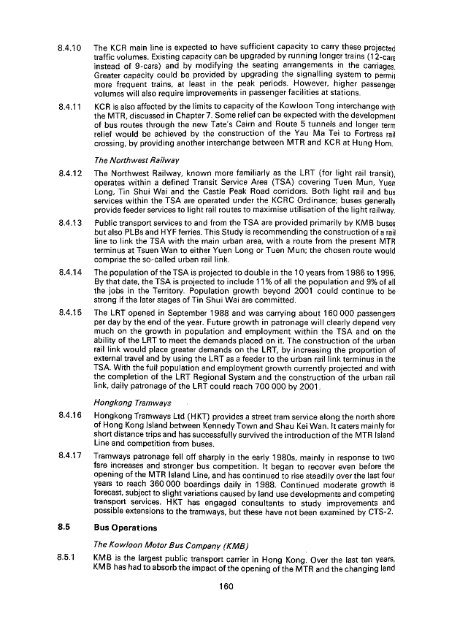Untitled - HKU Libraries - The University of Hong Kong
Untitled - HKU Libraries - The University of Hong Kong
Untitled - HKU Libraries - The University of Hong Kong
- No tags were found...
Create successful ePaper yourself
Turn your PDF publications into a flip-book with our unique Google optimized e-Paper software.
8.4.10 <strong>The</strong> KCR main Sine is expected to have sufficient capacity to carry these projectedtraffic volumes. Existing capacity can be upgraded by running longer trains (12-carsinstead <strong>of</strong> 9-cars) and by modifying the seating arrangements in the carriages.Greater capacity could be provided by upgrading the signalling system to permitmore frequent trains, at least in the peak periods. However, higher passengervolumes will also require improvements in passenger facilities at stations.8.4.11 KCR is also affected by the limits to capacity <strong>of</strong> the Kowloon Tong interchange withthe MTR, discussed in Chapter 7. Some relief can be expected with the development<strong>of</strong> bus routes through the new Tate's Cairn and Route 5 tunnels and longer termrelief would be achieved by the construction <strong>of</strong> the Yau Ma Tei to Fortress railcrossing, by providing another interchange between MTR and KCR at Hung Horn.<strong>The</strong> Northwest Railway8.4.12 <strong>The</strong> Northwest Railway, known more familiarly as the LRT (for light rail transit),operates within a defined Transit Service Area (TSA) covering Tuen Mun, YuenLong, Tin Shui Wai and the Castle Peak Road corridors. Both light rail and busservices within the TSA are operated under the KCRC Ordinance; buses generallyprovide feeder services to light rail routes to maximise utilisation <strong>of</strong> the light railway.8.4.13 Public transport services to and from the TSA are provided primarily by KMB busesbut also PLBs and H YF ferries. This Study is recommending the construction <strong>of</strong> a railline to link the TSA with the main urban area, with a route from the present MTRterminus at Tsuen Wan to either Yuen Long or Tuen Mun; the chosen route wouldcomprise the so-called urban rail link.8.4.14 <strong>The</strong> population <strong>of</strong> the TSA is projected to double in the 10 years from 1986 to 1996.By that date, the TSA is projected to include 11 % <strong>of</strong> all the population and 9% <strong>of</strong> allthe jobs in the Territory. Population growth beyond 2001 could continue to bestrong if the later stages <strong>of</strong> Tin Shui Wai are committed.8.4.15 <strong>The</strong> LRT opened in September 1988 and was carrying about 160000 passengersper day by the end <strong>of</strong> the year. Future growth in patronage will clearly depend verymuch on the growth in population and employment within the TSA and on theability <strong>of</strong> the LRT to meet the demands placed on it. <strong>The</strong> construction <strong>of</strong> the urbanrail link would place greater demands on the LRT, by increasing the proportion <strong>of</strong>external travel and by using the LRT as a feeder to the urban rail link terminus in theTSA. With the full population and employment growth currently projected and withthe completion <strong>of</strong> the LRT Regional System and the construction <strong>of</strong> the urban raillink, daily patronage <strong>of</strong> the LRT could reach 700 000 by 2001.<strong>Hong</strong>kong Tramways8.4.16 <strong>Hong</strong>kong Tramways Ltd (H KT) provides a street tram service along the north shore<strong>of</strong> <strong>Hong</strong> <strong>Kong</strong> Island between Kennedy Town and Shau Kei Wan. It caters mainly forshort distance trips and has successfully survived the introduction <strong>of</strong> the MTR islandLine and competition from buses.8.4.17 Tramways patronage fell <strong>of</strong>f sharply in the early 1980s, mainly in response to tw<strong>of</strong>are increases and stronger bus competition. It began to recover even before theopening <strong>of</strong> the MTR Island Line, and has continued to rise steadily over the last fouryears to reach 360000 boardings daily in 1988. Continued moderate growth isforecast, subject to slight variations caused by land use developments and competingtransport services. HKT has engaged consultants to study improvements andpossible extensions to the tramways, but these have not been examined by CTS-2.8.5 Bus Operations<strong>The</strong> Kowloon Motor Bus Company (KMB)8.5.1 KMB is the largest public transport carrier in <strong>Hong</strong> <strong>Kong</strong>. Over the last ten years,KM B has had to absorb the impact <strong>of</strong> the opening <strong>of</strong> the MTR and the changing land160
















